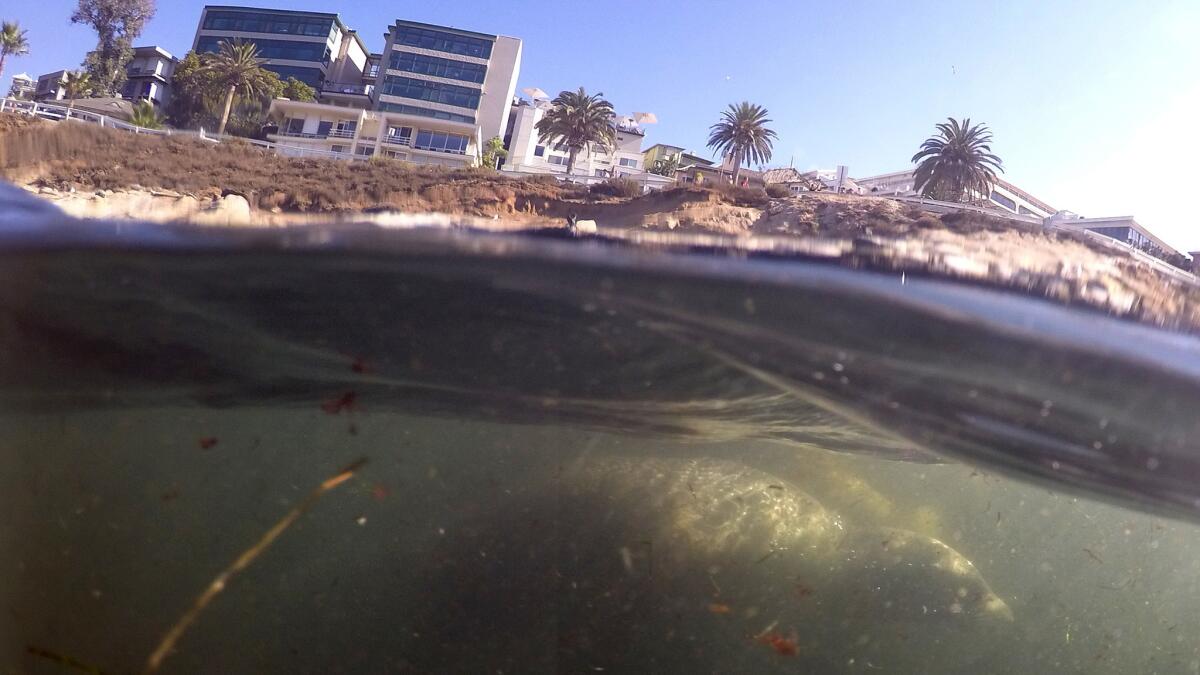Drought is reducing beach bacteria in Southern California, data shows

- Share via
California’s record-setting drought might be making area waters less prone to bacteria, according to government data.
The Environmental Protection Agency monitors the nation’s beaches for various indicators for contamination. In 2015, there were 762 beach advisories for San Diego County’s 46 beaches. The majority were because of rainfall pushing runoff into the ocean, but about one-fifth of closures were made because of bacteria.
That trend is on the downswing from a peak in 2013, according to an EPA database. In that year, there were nearly double the number of bacteria-related advisories, a spike that lessened as the California drought got underway.
A beach advisory is analogous to a weather warning. The water may be unsafe, but swimming and water activities aren’t prohibited. Only when certain conditions are met will a beach close.
The type and frequency of the advisories can vary beach by beach.
Beaches have a series of testing locations that send reports to the EPA. The larger the beach, the more EPA testing locations it has.
It is common for most advisories to last somewhere between three days to a week. When the water is dangerous to health, the advisories tend to last much longer.
Rainfall advisories are the most common. According to the nonprofit group Heal the Bay, advisories typically occur after there is at least one-tenth of an inch of rainfall, and last for three days.
A Heal the Bay study released earlier this year showed that Southern California saw significant improvements in beach water quality due to a reduction in polluted runoff into the Pacific Ocean, in part because of a lack of rain.
Southern California’s recorded average rainfall was way below normal. Downtown Los Angeles reported 58% of normal rainfall between January and April this year.
About 97% of Southern California beaches received an A or B grade for water quality during the busy summer months, according to the annual Beach Report Card.
Ocean Beach in San Diego shows that in real time: Even though there were some days when it rained, such as June 30 to July 1, 2015, there wasn’t a beach advisory because it didn’t rain enough. It is also possible for there to not be rain at the coast, but rain inland that could create an advisory.
Officials advise people to avoid beaches for three days following rainfall, regardless of advisories.
The EPA notes that rainfall in an advisory also tends to create higher levels of entero bacteria, which are an indicator of more fecal matter in the water.
Swimming in contaminated water can cause infections and illness. Symptoms include vomiting, fatigue and severe diarrhea.
Meredith Meyers, water quality lab coordinator for San Diego Coastkeeper, said that beach advisories shouldn’t be taken lightly.
The elevated bacteria advisories that last days suggest how extreme contamination is in a given area.
Parents of children should be careful, as children tend to be the most affected by the pathogens.
To help keep the beaches safe, Meyers recommends limiting runoff from all possible sources.
“Limiting runoff in your yard is one of the best things you can do,” Meyers said, “as well as picking up dog poop.”
Marine fecal matter causes many of the advisories at La Jolla Shores. That area is home to many sea lions, which raise their young there.
The sea lion pups remain on the shore while the mothers hunt, therefore their excrement remains near the shore for several months out of the year.
Cross-border contamination is an even larger threat.
The Imperial Beach municipal beach was closed for nearly all of November and December because of elevated bacteria levels.
The San Diego County Chapter of the Surfrider Foundation works to prevent cross-border contamination. The group estimates that the Tijuana Sloughs are closed for more than half of the year.
Earlier this year, a blockage of the Tijuana River became deadly as the stagnant water killed marine life. Imperial Beach Mayor Serge Dedina said that he counted at least 50 dead leopard sharks following the blockage.
Areas of Mission Bay are also prone to long advisories. The beach near the Mission Bay Visitor’s Center was under an elevated bacteria advisory for several months in 2015. There are several contributing factors: That part of the bay is so far inland that there is less water circulation than in other parts, and its proximity to the freeway also makes it prone to runoff.
In the Heal the Bay report, Monarch Beach in Dana Point ranked fourth on the list of the top 10 worst polluted beaches in the state, with Santa Monica Pier, Mother’s Beach in Marina del Rey and Redondo Municipal Pier coming in fifth, sixth and seventh, respectively.
Wheaton writes for the San Diego Union-Tribune.
dean.wheaton@sduniontribune.com
ALSO
Firefighters help passengers off Blue Line train that lost power
Venice prepares for annual topless parade and protest
Teen shot and killed in parking lot of Riverside church
More to Read
Sign up for Essential California
The most important California stories and recommendations in your inbox every morning.
You may occasionally receive promotional content from the Los Angeles Times.













